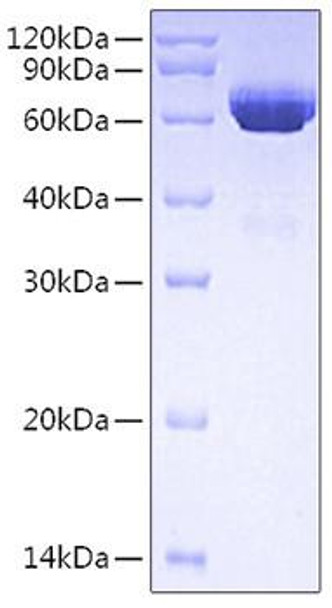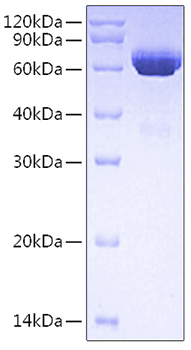Description
Recombinant Human Tissue-type plasminogen activator/TPA/PLAT Protein
The Recombinant Human Tissue-type plasminogen activator/TPA/PLAT Protein is a biologically active recombinant protein that plays a significant role in various cellular processes and signaling pathways in human biology. This protein is widely employed in immunological research, cell biology studies, protein-protein interaction analyses, and therapeutic development, providing researchers with a reliable tool for investigating Tissue-type plasminogen activator/TPA/PLAT function and its implications in health and disease.
This product (SKU: RPCB0722) is produced using HEK293 cells and features a C-6×His tag for convenient detection and purification. The protein exhibits a calculated molecular weight of 60.1 kDa with an observed molecular weight of 55-80 kDa under denaturing conditions, achieving ≥ 95 % as determined by SDS-PAGE., ensuring exceptional quality and consistency for research applications.
Key Features
| High Purity by Affinity Chromatography | |
| Mammalian & Bacterial Expression Systems | |
| High lot-to-lot consistency via strict QC |
| Product Name: | Recombinant Human Tissue-type plasminogen activator/TPA/PLAT Protein |
| SKU: | RPCB0722 |
| Size: | 10 μg , 50 μg |
| Reactivity: | Human |
| Synonyms: | PLAT, T-PA, TPA, TPA |
| Tag: | C-6×His |
| Expression Host: | HEK293 cells |
| Calculated MW: | 60.1 kDa |
| Observed MW: | 55-80 kDa |
| Gene ID: | 5327 |
| Protein Description: | High quality, high purity and low endotoxin recombinant Recombinant Human Tissue-type plasminogen activator/TPA/PLAT Protein (RPCB0722), tested reactivity in HEK293 cells and has been validated in SDS-PAGE.100% guaranteed. |
| Endotoxin: | < 1 EU/μg of the protein by LAL method. |
| Purity: | ≥ 95 % as determined by SDS-PAGE. |
| Formulation: | Lyophilized from a 0.2 μm filtered solution of 20mM MES,150mM NaCl,0.2mM CaCl2, pH5.5. Contact us for customized product form or formulation. |
| Reconstitution: | Centrifuge the tube before opening. Reconstitute to a concentration of 0.1-0.5 mg/mL in sterile distilled water. Avoid vortex or vigorously pipetting the protein. For long term storage, it is recommended to add a carrier protein or stablizer (e.g. 0.1% BSA, 5% HSA, 10% FBS or 5% Trehalose), and aliquot the reconstituted protein solution to minimize free-thaw cycles. |
| Storage: | Store at -20℃.Store the lyophilized protein at -20℃ to -80 ℃ up to 1 year from the date of receipt. After reconstitution, the protein solution is stable at -20℃ for 3 months, at 2-8℃ for up to 1 week. |
Tissue-type plasminogen activator (PLAT) is a protein that secreted into extracellular space. PLAT contains five domains:EGF-like domain, fibronectin type-I domain, 2 kringle domains and peptidase S1 domain. It belongs to the peptidase S1family. The main function of this protein is to convert plasminogen into biologically active plasmin. As a protease, PLATplays a crucial role in regulating blood fibrinolysis, maintaining the homeostasis of extracellular matrix and in modulatingthe post-translational activation of growth factors. PLAT is found not only in the blood, where its primary function is as athrombolytic enzyme, but also in the central nervous system (CNS). It participates in a number of physiological andpathological events in the CNS, as well as the role of neuroserpin as the natural regulator of PLAT's activity in theseprocesses. Increased or decreased activity of PLAT leads to hyperfibrinolysis or hypofibrinolysis, respectively. In addition, asa cytokine, PLAT plays a pivotal role in the pathogenesis of renal interstitial fibrosis through diverse mechanisms. Thus, as afibrogenic cytokine, it promotes the progression of kidney diseases.







